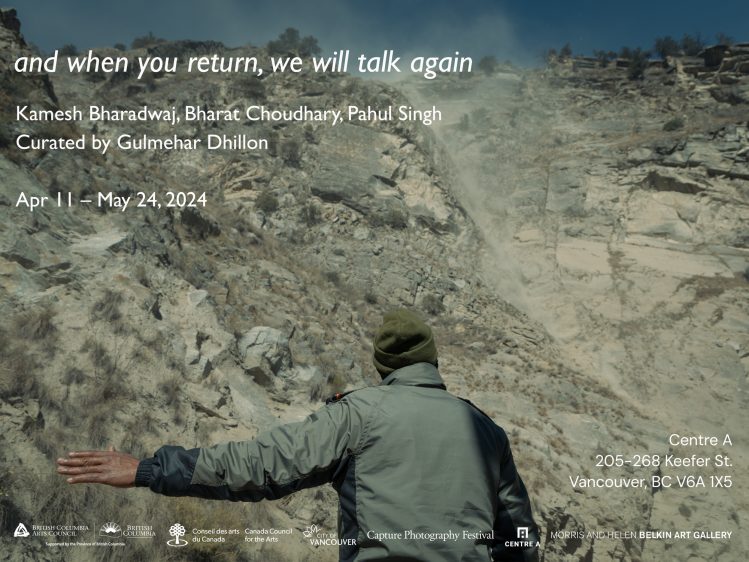 and when you return, we will talk again
and when you return, we will talk again
Bharat Choudhary, Kamesh Bhardawaj, Pahul Singh
–
Curated by Gulmehar Dhillon
April 11 – May 24, 2024
Opening: April 11, 5 – 8 PM
Gallery Hours: Wednesday to Saturday, 12 PM – 6 PM
–
The act of migration involves departing from one’s place of origin to settle elsewhere, forming the foundation of the migrant experience. This transition encompasses both a detachment from the original place and a sense of continual movement or flux. Migration, a fundamental aspect of human history, has evolved alongside globalization and the emergence of nation-states and political boundaries. In today’s context, marked by heightened polarization and fervent embrace of differences, the implications of these movements have undergone significant shifts.
and when you return, we will talk again considers the complex narratives of migration that extend across South Asia and its diaspora. This exhibition explores the evolving essence of the region, transcending political borders and examining themes of belonging and estrangement. Through the showcased works, we reflect on the expanding and evolving identity of South Asia, beyond mere geographical confines, shaped by growing diasporas and evolving political dynamics. It grapples with the profound sense of displacement, whether by choice or circumstance and contemplates the evolving concept of ‘home’.
Through the works of Bharat Choudhary, Kamesh Bharadwaj, and Pahul Singh, the exhibition reflects on nostalgia, longing, and yearning to preserve what remains in memory. Embedded within their works are the complex politics of belonging, where individuals and communities navigate constantly shifting identities. The exhibition also delves into the lasting impacts of colonialism, shedding light on the complex interplay between power and displacement, ranging from internal migrations to the broader ramifications of climate crises, exacerbated by profit-driven capitalism and government policies. Through this exploration, the exhibition facilitates a journey back to realms of remembrance and imagination, weaving together experiences that resonate with displacement, identity, and the enduring echoes of the past, fostering a deeper understanding of the migrant experience in all its complexities.
We explore the theme of journeys and the elusive notion of return. In the contemporary global landscape, the prospect of returning home may be fraught with challenges, especially when the familiar notion of ‘home’ undergoes radical transformations. However, amidst this uncertainty, the exhibition hopes to initiate a dialogue that refuses to conclude.
Kamesh Bharadwaj’s untitled project unfolds as he journeys across the Kinnaur region of Himachal Pradesh in India. This reflective journey intersects with themes of mental health, climate crises and identity. Bharadwaj delves into the fluidity of identity shaped through oral histories, indigenous customs, and the impact of climate change. This collection of photographs encapsulates changing landscapes shaped by human influence, prompting contemplation on the consequences of capitalist pursuits and governmental policies in the Anthropocene era. It also explores individual and collective modes of existence, livelihoods, and knowledge systems.
Reflecting on recent events, this work emerges as a timely response to the surge of developmental projects initiated by state and national governments. These projects, frequently outsourced to private companies, often neglect ecological standards and fail to uphold the integrity of nature. The community with whom Bharadwaj resided and collaborated faced the looming shadow of displacement as their lands were earmarked for the development of hydro-electric projects, highlighting a pervasive form of forced internal displacement, affecting not only the Kinnaur community but also numerous others across this region and the country. These circumstances prompt crucial inquiries into the beneficiaries of these projects and the true intent behind their implementation. Moreover, they contemplate the profound human connection to land and place, and the consequences when people are forcibly uprooted from their homes.
Bharat Choudhary’s Elemental Conversations Within encapsulates his five-year journey through Europe and the United States, characterized by introspection and a quest for belonging. Through a blend of fiction and reality portrayed through photographs and text, he is looking at the everyday while grappling with internal conflicts, melancholy, and nostalgia. Within the broader context of South Asian migration to the West, Choudhary’s work offers an understanding of migration and personal identity. The diaristic format of the photographs and text reflects the intimate and deeply introspective nature of self-questioning. His narrative of journeying and returning, coupled with introspective questioning about the notion of home, contemplates the complexities of personal identity and the shifting nature of home, raising questions about whether home ever remains the same once departed from.
Ikk Kambdi Lakeer / A Quavering Line by Pahul Singh considers the oral history of the 1947 Partition of India and Pakistan. Presented as fragmented video work, it navigates the complexities of language and silence, histories, and the enduring sense of displacement. Each close-up shot captures individuals speaking and their voices are visually represented through a quavering line—a symbolic portrayal of boundaries, fractures, connections and narratives. The line trembles and oscillates in response to the speaker’s voice, resolute in its refusal to stabilize, allowing the voice to persist even in its absence. Singh’s approach mirrors the fragmented nature of memory and shared histories, shedding light on remembering, recalling and reconstruction in individual and collective narratives.
Additionally, the work juxtaposes the element of soundlessness or conspicuous absence of sound with the palpable anticipation of sound. This contradiction arises from the expectation of auditory cues in the silence, which remains unresolved, akin to the threading of a needle that never reaches completion in one of the videos. Audiences are compelled to hear through another lens—directly through the quivering line—experiencing the narrative through their eyes as much as their ears. This aspect is significant given that the title of the show itself hints at a similar sense of anticipation. Furthermore, the work addresses tensions between aural, visual, and textual registers. It outlines the complexities and interplay between these different modes of expression, as well as the ways they intersect with processes of remembering, intimacies, and public discourse.
The works showcased in the exhibition reflect on the intricate intersections of national, political, and cultural boundaries, thinking about the hybrid spaces that emerge from the movement of people. By challenging conventional narratives surrounding immigration, these works offer a perspective on the complex forces driving migration, while also highlighting the enduring resilience of culture in the face of displacement.
— Gulmehar Dhillon
–
Artist Biography
Kamesh Bharadwaj is a documentary photographer based in Bangalore. His interests lie in studying the consequences of the climate crisis in India. Coming from a background in journalism and sociology, he critically explores the idea of development and the effects of the same on access and management of common resources. He hopes to explore everyday processes that propagate the climate crisis, focusing on people and communities that are most vulnerable to it due to class, caste, and geography. He hopes that his practice is open to generative dialogue with multiple perspectives and narratives to emerge.
Bharat Choudhary is an independent photographer based between London and New Delhi. He has an MA in Journalism from the University of Missouri. He has been a recipient of the Ford Foundation International Fellowship, Alexia Foundation Professional Grant and the Getty Images Grant for Editorial Photography. He has thrice been a finalist for the W. Eugene Smith Grant and a finalist for the Aftermath Grant and the Philip Jones Griffiths Award. His work has been published in TIME, NY Times, Le Monde, International Herald Tribune, The National, Neue Zürcher Zeitung, La Repubblica, Philosophie, and the Sunday Times Magazine.
Pahul Singh is a practitioner based in Rajasthan, India. She holds an MVA in Painting from The Faculty of Fine Arts, MSU Baroda. She looks at translation, authorship and re-authorship, and forms of displacements positioned in and around the book/expanded books. She is a recipient of the Emerging Artist Award by the Foundation of Indian Contemporary Art (2022) and the Scholarship to Young Artists awarded by the Ministry of Culture, Government of India (2019-20). Her participations include ‘Embark IV and V’ by Ark Foundation for the Arts (Vadodara), ‘Perceptual Transfers’ a video programme by VAICA for ‘Mycelial Legacies’ (New Delhi), KHOJ Peers Residency (New Delhi), among many others.
Curator Biography
Gulmehar Dhillon is a photographer and curator from New Delhi. She is currently a Master’s candidate in Art History (Critical Curatorial Studies) at the University of British Columbia; she holds an undergraduate degree in Journalism with honours from the University of Delhi. Her research focuses on the intersection of lens-based practices, methodologies and activism, embodying a conception of art as an instrument of resilience and dissent.
Dhillon has previously held positions at Sri Aurobindo Centre for Arts and Communication (New Delhi), ASAP | Art (New Delhi), Liu Lobby Gallery (UBC, Vancouver) and the Morris and Helen Belkin Art Gallery (Vancouver) in different capacities. Her photographic works have been exhibited at Printer Matter (New York), Double Dummy Studios (Arles), Arthshilla (Ahmedabad) and Offset Projects (New Delhi), among others. She was the recipient of the Audain Graduate Fellowship in 2022, and MurthyNayak Foundation’s Social Documentary Photography Grant in 2021.
–
This exhibition is part of the 2024 Capture Photography Festival Selected Exhibitions Program.
With support from the Audain Endowment for Curatorial Studies through the Department of Art History, Visual Art and Theory in collaboration with the Morris and Helen Belkin Art Gallery at The University of British Columbia.
 ________________________________________________________________________________________________________
________________________________________________________________________________________________________
Accessibility: The gallery is wheelchair and walker accessible. If you have specific accessibility needs, please contact us at (604) 683-8326 or [email protected]. Centre A is situated on the unceded territories of the Musqueam, Squamish, and Tsleil-Waututh peoples. We honour, respect, and give thanks to our hosts.









